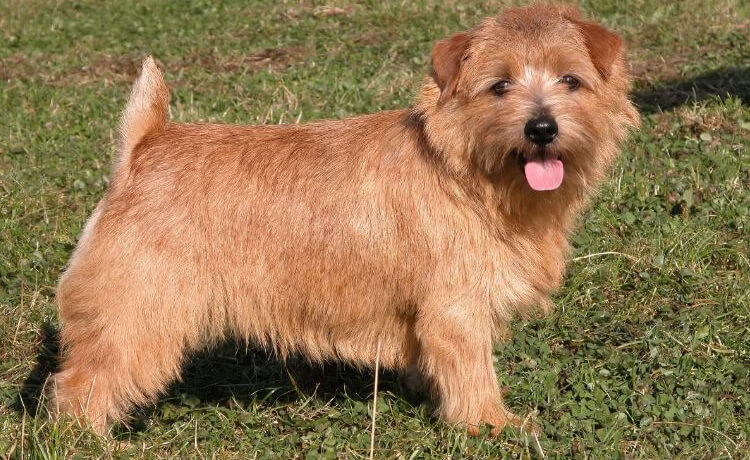
Norfolk Terrier
The Norfolk Terrier may be one of the smallest terrier breeds, but it packs a big personality! Known for its outgoing nature, intelligence, and adaptability, this breed is a delightful companion for families, singles, and even apartment dwellers.
Key Features of the Norfolk Terrier
-
Size and Appearance:
- Height: 9–10 inches.
- Weight: 11–12 pounds.
- Coat: A weather-resistant, wiry double coat, usually in shades of red, wheaten, black, tan, or grizzle.
- Distinctive Features: A compact body, expressive almond-shaped eyes, and small, folded ears that give the breed its charming appearance.
-
Temperament:
Norfolk Terriers are friendly, fearless, and affectionate. They thrive on companionship and enjoy being involved in family activities. -
Energy Level:
Moderate to high energy, requiring regular exercise and mental stimulation.
History and Origin of the Norfolk Terrier
-
Roots in England:
The Norfolk Terrier originated in East Anglia, England, during the late 19th century. It was bred to control vermin on farms and in stables, as well as to serve as a loyal companion. -
Development of the Breed:
Originally grouped with the Norwich Terrier, the Norfolk Terrier was distinguished by its folded ears, whereas the Norwich Terrier has erect ears. In 1964, they were recognized as separate breeds. -
Recognition and Popularity:
The Norfolk Terrier gained recognition by the American Kennel Club (AKC) in 1979 and remains a popular choice for its charming personality and manageable size.
Exercise and Training Needs
-
Daily Exercise:
Norfolk Terriers are active little dogs that require at least 30–45 minutes of daily exercise. Activities like brisk walks, playtime in a secure yard, or engaging in dog sports can keep them happy and healthy. -
Mental Stimulation:
These intelligent dogs need mental challenges. Training sessions, puzzle toys, or interactive games help prevent boredom and destructive behaviors. -
Training Tips:
- Positive Reinforcement: Use treats, praise, and play to encourage good behavior.
- Early Socialization: Introduce your Norfolk Terrier to new environments, people, and other pets early to ensure a well-rounded adult dog.
- Firm Consistency: Although affectionate, they can be stubborn. Consistent training is key.
-
Behavioral Traits:
Norfolk Terriers may have a strong prey drive due to their hunting background. They should always be leashed or in a fenced area when outdoors.
Grooming and Coat Care
Essentials for Your Newly Adopted Pet
Welcoming a shelter pet into your life is a beautiful journey. Here are some handpicked items to help your new friend feel safe, loved, and right at home:
-
Coat Maintenance:
The Norfolk Terrier’s wiry coat is relatively low-maintenance but benefits from regular grooming:- Brushing: Brush their coat 2–3 times a week to prevent tangles and remove debris.
- Hand-Stripping: Occasional hand-stripping helps maintain the coat’s texture and appearance, especially for show dogs.
-
Bathing:
Bath only when necessary, typically every 2–3 months, as frequent bathing can strip the coat of its natural oils. -
Other Grooming Needs:
- Ears: Check and clean weekly to prevent infections.
- Nails: Trim regularly to prevent overgrowth and discomfort.
- Teeth: Brush several times a week to promote dental health.
Health Considerations
-
Lifespan:
The Norfolk Terrier typically lives 12–15 years, making it a long-lived companion. -
Common Health Issues:
While generally healthy, some Norfolk Terriers may be prone to:- Hip Dysplasia.
- Patellar Luxation(kneecap dislocation).
- Mitral Valve Disease(a heart condition).
- Eye Disorders, such as cataracts or dry eye.
Regular veterinary check-ups and a balanced diet are essential for maintaining their overall health.
Fun Facts About the Norfolk Terrier
-
One of the Smallest Working Terriers:
Despite their size, Norfolk Terriers are fearless and hardworking, often taking on tasks much larger dogs might avoid. -
Farm Heroes:
Originally bred to hunt vermin, these terriers were indispensable on farms, keeping rodent populations in check. -
A Social Butterfly:
Norfolk Terriers are incredibly people-oriented and thrive in households where they get plenty of attention and companionship. -
Distinct Ears:
The breed’s folded, or "drop," ears set it apart from its close cousin, the Norwich Terrier. -
Hypoallergenic Qualities:
Though not completely hypoallergenic, the Norfolk Terrier’s low-shedding coat is often better suited for individuals with mild allergies.
Is the Norfolk Terrier Right for You?
The Norfolk Terrier is a delightful choice for those seeking a small but spirited companion. Their friendly demeanor and manageable size make them an excellent fit for families, singles, and even first-time dog owners. However, their active nature means they need regular exercise and mental stimulation to prevent boredom.
If you’re looking for a loyal, playful, and affectionate dog that thrives on attention and companionship, the Norfolk Terrier could be your perfect match!
Affiliate Products
